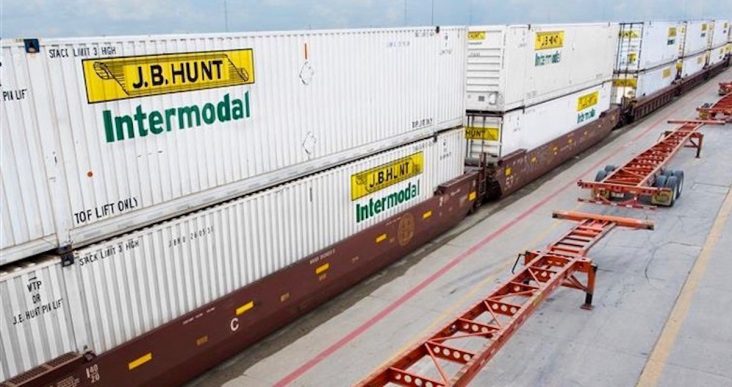Analysts: J.B. Hunt Q2 revenue, earnings to fall as freight slump continues
by July 12, 2024 10:05 am 279 views

Lowell-based carrier J.B. Hunt Transport Services Inc. is expected to post declines in earnings and revenue in the second quarter amid a challenging freight market. However, analysts noted “potential catalysts” that could lead to an improving market in the second half of 2024.
After the markets close Tuesday (July 16), J.B. Hunt is expected to report earnings declined to $1.53 per share in the second quarter from $1.81 per share in the same period last year, based on a consensus of 17 analysts. Revenue is expected to fall by 2.5% to $3.06 billion from $3.13 billion.
In an earnings preview, analyst Daniel Imbro and associates Brady Lierz, Joe Enderlin, Collin Nieman and Reed Seay, all of Little Rock-based Stephens Inc., expect second-quarter intermodal volumes to rise from the first quarter of 2024 and the second quarter of 2023. The carrier’s intermodal segment is its largest by revenue and operating income.
J.B. Hunt’s intermodal volumes fell slightly in the first quarter. Still, second-quarter volumes are projected to be lower than domestic Intermodal Association of North America (IANA) volumes, up 7% quarter-to-date through May this year from last year.
“We expect industry fundamentals to remain challenged near term but see a number of potential catalysts on the horizon, including a potential tightening in the truck market in the (second half of 2024), as well as the potential tailwind from increased transloading following the recent sharp rise in ocean rates,” the analysts said.
J.B. Hunt intermodal margins are expected to improve by about 0.1 percentage points to 7.4% from the first quarter as the company might “leverage its advantaged cost structure to drive growth” in some lanes, analysts said. The metric looks to be “most in focus for investors into the quarter.”
The intermodal sector of the transportation industry is consolidated compared to other parts of the industry, and four public companies, including J.B. Hunt, comprise about 55% of the domestic market. J.B. Hunt accounts for the largest portion of that percentage, with about 120,000 domestic containers or roughly one-third of the total market. It also has the largest drayage truck fleet in North America.
“After a volatile few years, today we find the market with ample excess capacity (20%- 25% of containers stacked) and a very competitive pricing backdrop,” the analysts said. “While IANA data would suggest that the intermodal market has returned to growth, digging into this deeper shows a less favorable backdrop; domestic intermodal volume is only up (about) 1.8% while international volume is up (about) 18.5% (year-to-date).”
The analysts attributed the rise to easier comparisons to the first half of 2023, retail destocking and excess container supply in the ocean market for most of 2024. As a result, ocean carriers don’t need the 20-foot or 40-foot containers back as quickly and are being sent inland instead of the freight being transloaded from them to a domestic 53-foot container.
However, this could change as transpacific rates have risen over 125% since May 1. Continued strength could lead to higher levels of transloading in the second half of 2024. Analysts noted that they expect more freight to be pushed to rails as the truckload market improves. They added that the market is “closer to the bottom,” but when it turns, even more freight could be pushed to the rails than in past cycles. Railroads are focused on increasing carload growth in the coming years.
“The company’s goal of reaching 150,000 containers has spooked the market in terms of structurally adding capacity, but we believe this speaks to (J.B. Hunt’s and the rail industry’s) focus on intermodal growth in the coming years,” analysts said. “Additionally, we viewed the recent acquisition of (Walmart’s) intermodal containers as a prudent way to grow – not adding industry capacity by acquiring existing assets and phasing them into operations as they are retrofitted, which delays near-term impact. We do believe that intermodal margins could remain softer in the near term, but if growth improves, we believe shares can work in (the second half) as investors look toward the recovery next year.”
Following is a preview of J.B. Hunt’s other segments.
Dedicated
The analysts noted the segment has been “the highlight of (J.B. Hunt’s) financial performance” over the past 12 to 18 months. The segment expects to sell between 1,000 and 1,200 trucks in 2024, and in the first quarter, it sold more than 600. The segment operates about 13,000 trucks and 32,000 trailers on long-term contracts. Its contract retention rate is more than 90%.
Brokerage
The analysts said this segment “has experienced meaningful earnings volatility in recent years, as the freight brokerage market has been challenged and profitability is burdened by elevated investments in people and technology.” In the medium term, they expect the segment to continue to lose money. Operating income is expected to fall by double digits in the second quarter.
Truck and Final Mile
According to the analysts, the Final Mile segment is expected to report stable results in the near term. After completing five acquisitions since 2017, the company operates the largest U.S. network. The truck segment has evolved into more of an asset-light model, and its 360box program, which comprises a trailer fleet for drop-and-hook capacity, has outperformed the broader market. The changes are expected to improve the segment’s returns and margins.
The analysts posted an overweight (buy) rating for J.B. Hunt shares. Shares of J.B. Hunt (NASDAQ: JBHT) closed Thursday (July 11) at $163.31, up $3.53 or 2.21%. In the past 52 weeks, the stock has ranged between $153.12 and $219.51.
